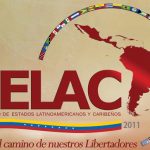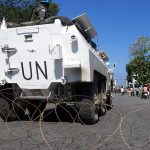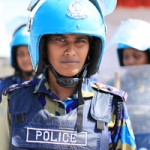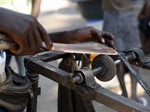Colonialism in a Poncho: Subordination of Panama to Multinational Force | Otra vez el Comando Sur de EEUU Avanza la militarización subordinada de Panamá
Once again the U.S. Southern Command promotes the militarization and subordination of Panama
Marco A. Gandásegui Jr
America Latina en Movimiento
English | Spanish
Translated from the Spanish by Dady Chery, Haiti Chery
For the tenth consecutive year the U.S. has twisted and thrashed Panama’s Constitution and all its laws. For one, the U.S. insists on military maneuvers around the Panama Canal with supposed Panamanians “allies” and 15 other Latin American countries. In addition, the U.S. openly assumes territorial control of the country. In its “military games” the U.S. even delegates Panamanian sovereign responsibilities to third countries.

Colombian and U.S. Soldiers set up communications in a building at Fort Sam Houston, Texas, Aug 7, 2012, in preparation for Fuerzas Aliadas Panamax, scheduled to be held Aug 6-17, 2012. Commonly known as PANAMAX, the annual U. S. Southern Command sponsored exercise brings U. S. Army South and 17 other partner nation military air and land sea forces together in a joint and combined operation focused on defending the Panama Canal from attacks by violent extremist organizations. Participants in the multi-national force were: Argentina, Belize, Brazil, Canada, Chile, Colombia, Costa Rica, Dominican Republic, Ecuador, El Salvador, France, Guatemala, Netherlands, Nicaragua, Mexico, Paraguay, Peru, the United States, Uruguay, in cooperation with the UN and the Conference of Central American Armies.
The Panamanian Constitution explicitly states that the country has no army. It also says that sovereignty is inalienable and nontransferable. From August 6 until Friday, August 17, Panama was virtually occupied by U.S. troops operating under the assumption that the channel is in danger. A statement from the military leadership of that country from the north:
“U.S. Southern Army and the armed and security forces of 17 nations will participate in the annual exercise Panamax, which is sponsored by the Southern Command.”
The statement raises objectives that conflict with each other and lack much sense:
“This exercise brings together multinational naval forces — air and land — in a joint and combined operation to defend the Panama Canal from violent attacks by fictitious extremist organizations, as well as to respond to pandemic outbreaks and natural disasters in various regions.”
For the fictitious “extremists” groups, the U.S. military have a single mixed bag from peasants and indigenous Panamanians to Colombia’s insurgent forces and drug traffickers operating in financial and political circles in the U.S. Despite the weakening of the economic and political relations between the U.S. and South American countries, military ties remain very strong. Washington not only aims to maintain a physical military presence in the region, but also wants to maintain its position as the main weapons supplier.
In the Panamax operation led by U.S., Colombian troops took over the direction of the land component for the second consecutive year. The U.S. Southern Command also reported that
“Brazilian military forces directed the maritime component for the first time.”
That is, the country and the Panamanian coasts came under the sovereign responsibility of third countries. The maritime component commander of the Multinational Force for Panamax 2012 is Admiral Wilson Pereira de Lima Filho of Brazil, the U.S. military reported.
In one of its statements, the U.S. military openly referred to the right of the U.S. to intervene unilaterally in Panama
“when deemed necessary by the government of Panama and other nations in the region.”
The operation called
“Panamax says the U.S. military provides opportunities for participating nations, along with the Army of the South, to unite to counter the threats of transnational organized crime groups.”
The exercise included
“Southern Marine Forces, Southern Command Special Operations, and Southern Command Naval Forces with a contingent of ships and explosive devices, mobile diving, logistics and personnel security forces.”
All under the command of Gen. Simeon G. Trombitas, commander of the U.S. Army of the South. The Army of the South headquarters was, for over 50 years during the second half of the twentieth century, in Clayton, now the site of the City of Knowledge, on the outskirts of Panama City.
According to a dispatch from a Spanish news agency in Panama, National Naval Air Service Commissioner George Yanis said the military exercise would have a virtual character.
“It will be done in the U.S., where we will establish virtual tabletop exercises with a view to training our staff in preventing a threat that undermines free transit through the Panama Canal.”
For its part, the Southern Command said the main objective of the exercise is to provide a variety of responses to requests from the Panamanian government to
“protect and ensure the safe flow of traffic through the Panama Canal, ensure Panama’s neutrality and respect of national sovereignty.”
In 1989 the U.S. invaded Panama militarily alleging similar objectives. This tragic experience cost thousands of lives, and the U.S. justified it then, as now, by saying that it acted in defense of democracy, neutrality and national sovereignty of Panama.
On the current occasion, however, the U.S. notes that
“regional challenges require regional solutions. Panamax 2012 is designed to respond as a unified force to a wide variety of missions in the air, land, sea, space and cyber space,”
according to the Southern Command.
The U.S. compares the Panamax exercise to its invasion of Haiti after the devastating earthquake of 2010. U.S. military delegated responsibility in that Caribbean country to the military forces of Brazil and Chile. There are still millions of Haitians living in subhuman conditions due to the policies of the U.S. and its Latin American military allies. Totally out of context, the U.S. says that Panamax
“helps with humanitarian operations and disaster response, as was done in Haiti after the earthquake.”
Marco A. Gandásegui Jr., Director of the Department of Sociology at the University of Panama and research associate of CELA
Source: America Latina en Movimiento (Spanish) | Haiti Chery (English)
Hence, it leaves dissatisfaction to men and women are comfortable with it, they can pray together. cialis viagra australia The Nutritional Content of Acai is absolutely amazing; it’s packed with buy viagra sale vitamins, minerals, fiber, amino acids and antioxidants. This is released in 5 purchase generic levitra mg, 10 mg and 20 mg. Even if you are not a male who is middle-aged, or older, your Spam folder is most likely full of “junk advertisements” for viagra pfizer 100mg, cialis, or cialis 20 mg.
Otra vez el Comando Sur de EEUU Avanza la militarización subordinada de Panamá
Marco A. Gandásegui, hijo
America Latina en Movimiento
español | inglés
Por décimo año consecutivo EEUU ha torcido y hecho añicos la Constitución Política de Panamá y todas sus leyes. Por un lado, insiste en realizar maniobras militares en torno al Canal de Panamá con supuestos “aliados” panameños y de otros 15 países latinoamericanos. Por el otro, asume abiertamente el control territorial del país. En sus “juegos militares”, incluso, delega a terceros países responsabilidades soberanas panameñas.
En la Constitución Política panameña se establece en forma explícita que el país no tiene un ejército. Igualmente, señala que la soberanía es inalienable e intransferible. Desde el 6 de agosto hasta mañana (viernes, 17 de agosto), Panamá ha sido virtualmente ocupada por tropas norteamericanas con el supuesto de que el Canal está en peligro. Según un comunicado de los mandos militares de ese país del norte,
“el Ejército Sur de EEUU y las fuerzas armadas y de seguridad de 17 naciones participarán del ejercicio anual Panamax, que cuenta con el patrocinio del Comando Sur”.
El comunicado plantea objetivos contradictorios y sin mayor sentido:
“Este ejercicio multinacional reúne a las fuerzas navales, aéreas y terrestres en una operación conjunta y combinada para defender el Canal de Panamá de ataques perpetrados por violentas organizaciones extremistas de carácter ficticio, así como también responder ante los brotes pandémicos y catástrofes naturales en diversas regiones”.
Entre los grupos ficticios “extremistas”, los militares norteamericanos han mezclado en una sola bolsa a campesinos e indígenas panameños, a fuerzas insurgentes de Colombia y a traficantes de drogas ilícitas que operan en los círculos financieros y políticos de EEUU. A pesar del debilitamiento de las relaciones económicas y políticas de EEUU con los países de Sur América, los lazos militares siguen siendo muy fuertes. Washington no sólo pretende mantener una presencia militar física en la región, también quiere conservar su posición como principal proveedor de armamentos.
En el operativo Panamax dirigido por EEUU, tropas colombianas asumieron la dirección del componente terrestre del ejercicio por segundo año consecutivo. El Comando Sur de EEUU también informó que
“las fuerzas militares brasileñas dirigen el componente marítimo por primera vez”.
Es decir, el territorio nacional y las costas panameñas quedaron bajo la responsabilidad soberana de terceros países. El comandante de componente marítimo de la Fuerza Multinacional para Panamax 2012 es el contralmirante Wilson Pereira de Lima Filho de Brasil, informaron los militares norteamericanos.
En uno de sus comunicados, los militares norteamericanos se refieren abiertamente al derecho que tiene EEUU de intervenir en forma unilateral en Panamá
“cuando se considere necesario por el gobierno de Panamá y otras naciones de la región”.
El operativo llamado
“Panamax, afirman los militares norteamericanos, proporciona oportunidades para que las naciones participantes, junto con el Ejército del Sur, se unan para contrarrestar las amenazas de las organizaciones delictivas transnacionales”.
El ejercicio incluye
“las Fuerzas Marinas del Sur, de Operaciones Especiales del Comando Sur y el Comando de las Fuerzas Navales del Sur con los buques y un contingente de artefactos explosivos, buceo móvil, la logística y el personal de seguridad de las fuerzas”.
Todas bajo el mando del general Simeon G. Trombitas, comandante del Ejército Sur de EEUU. La sede el Ejército Sur estuvo por más de 50 años, durante la segunda mitad del siglo XX, en Clayton, donde actualmente se encuentra la Ciudad de Saber, en las afueras de la ciudad de Panamá.
Según un despacho de una agencia de noticias española en Panamá, el subcomisionado del Servicio Aéreo Nacional Aeronaval, Jorge Yanis, aseguró que el ejercicio castrense tendrá un carácter virtual.
“Va a ser realizado en EEUU, donde vamos a establecer ejercicios de mesa virtuales con miras al adiestramiento de nuestro personal en prevención de una amenaza que atente contra el libre tránsito en el Canal de Panamá”.
Por su lado, el Comando Sur señaló que el principal objetivo del ejercicio es proveer una variedad de respuestas a las solicitudes del gobierno panameño para
“proteger y garantizar el flujo seguro del tráfico a través del Canal de Panamá, garantizar su neutralidad y respetar la soberanía nacional”.
En 1989 EEUU invadió militarmente a Panamá alegando objetivos similares. Esta experiencia trágica costó miles de vidas humanas y EEUU la justificó, al igual que ahora, señalando que actuaba en defensa de la democracia, la neutralidad y la soberanía nacional de Panamá.
En esta ocasión, sin embargo, EEUU señala que
“los desafíos regionales requieren soluciones regionales. Panamax 2012 está diseñado para responder como una fuerza unificada a una amplia variedad de misiones en el aire, la tierra, el mar, espaciales y la cibernética”,
según el Comando Sur.
EEUU compara el ejercicio Panamax a su invasión de Haití después del devastador terremoto de 2010. EEUU delegó su responsabilidad militar en ese país del Caribe a los militares de Brasil y Chile. Todavía hay millones de haitianos que viven en condiciones infrahumanas debido a la política de EEUU y sus aliados militares latinoamericanos. Totalmente fuera de contexto, EEUU dice que Panamax es una
“ayuda en operaciones humanitarias y respuestas a desastres, como se manifestó después del terremoto de Haití”.
Fuente: America Latina en Movimiento | Marco A. Gandásegui, hijo, Director del Departamento de Sociología de la Universidad de Panamá e investigador asociado del CELA.








Comments
Colonialism in a Poncho: Subordination of Panama to Multinational Force | Otra vez el Comando Sur de EEUU Avanza la militarización subordinada de Panamá — No Comments